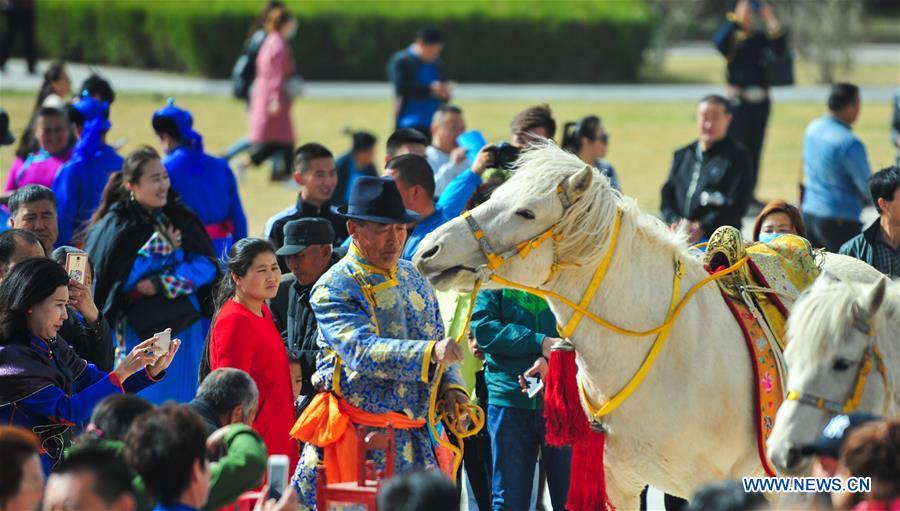
Worshippers pray for good fortune during a grand memorial ritual for the 13th-century great conqueror Genghis Khan at the mausoleum of Genghis Khan in Ordos, north China's Inner Mongolia Autonomous Region, April 17, 2017. The annual spring ceremony for Genghis Khan has been practiced for nearly 800 years. Worshippers stepped into the shrine, offering hada, a ceremonial silk scarf, and tea bricks, among other offerings. Genghis Khan's relics are enshrined at the site. (Xinhua/Lian Zhen)
HOHHOT, May 1 (Xinhua) -- Eight-hundred years after Genghis Khan created the largest empire in human history, his global influence continues today, especially among Chinese Mongolians.
Memorial rituals, large and small, take place all year round in the Mausoleum of Genghis Khan on the grasslands of Ordos city, Inner Mongolia Autonomous Region, northern China.
The grandest ceremony in the sacred mausoleum is held on the 21st day of the third lunar month each year, attracting as many as 100,000 Mongolians from the region and other places. People give offerings such as cooked mutton and tea bricks, and pray for happiness in the shrine, which comprises three yurt-like palaces.
ANCESTOR WORSHIP AND PRIDE
Genghis Khan (1162-1227), founder of the Mongol Empire, died aged 66 when he attacked the Xixia Kingdom while trying to unify the country. The sacrificial rituals have lasted since the 13th century.
"With such convenient transport, more and more people come to attend the ceremony," said Qimbai, 36, a worker at the shrine. "My responsibility is to pass on the sacrificial culture."
The mausoleum was completed in 1955 and has undergone renovation and expansion several times since. The path to the mausoleum has 99 stairs as Mongolians believe the number nine is lucky.
The Dalhut people, or "guards of the sacred mausoleum" in Mongolian, protect the Mausoleum of Genghis Khan and are in charge of organizing the sacrificial services.
But unlike the previous Dalhut people who lived poor lives, Dalhut staff in the mausoleum like Qimbai receive government salaries. Their living conditions have much improved.
As their population grows, some Dalhut people continue to watch the mausoleum, while others go into business. Some even go abroad for study.
Ethnic Mongolians also feel great pride in the well-preserved Yuan Shangdu ruins, also known as Xanadu, in Zhenglan Banner, Xilingol League. The ancient capital was built in 1256, and Genghis Khan's grandson Kublai Khan, the first Yuan Dynasty emperor, was enthroned here in 1260. It was one of the two major capitals of the dynasty with the other in today's Beijing. Xanadu was destroyed in a peasant war at the end of the dynasty.
Italian explorer Marco Polo (1254-1324), described Xanadu in his book, Marco Polo's Travel Notes. The Xanadu site was inscribed on the World Heritage List in 2012.
"It has been part of my life," said Gegenhas, a Mongolian who works as an interpreter for visitors at the site. "Local Mongolians pass on the traditional culture. Their dialect is the standard pronunciation of China' s Mongolian language."
Nearly 300 households of herdsmen, both Han and Mongolian, used to live in the relics area. When it applied for world heritage status, they voluntarily moved out without demanding any compensation except grasslands and houses, according to Zhuang Yongxing, head of the Xanadu cultural heritage administration bureau of Xilingol League.
The centuries-old sacrificial services at the Mausoleum of Genghis Khan may eventually receive world's intangible cultural heritage status, and the rituals were put on the national list of intangible cultural heritage in 2006.
Naqig, former deputy head of the Mausoleum of Genghis Khan tourist zone commission, said the mausoleum ritual culture combined political, economic and nomadic aspects of Mongolian life, reflecting harmony between man and nature.
Scholars from more than 40 countries carry out research on Genghis Khan, and some believe his role in globalization deserves attention.
"The history of the Mongol Empire and the Yuan Dynasty has long been an international branch of study," said Gombzarb, a Mongolian poet and chairman of the Inner Mongolia Federation of Literary and Art Circles.
Gombzarb and a Mongolian colleague translated the "Secret History of the Mongols," the earliest Mongolian historical literature, believed to be completed in the 13th century, into modern Chinese. Their version was a best seller in China after it was published in 2006.
"Over the past three decades, China has strengthened research in the history and culture of Mongolians, and a group of bilingual Chinese-Mongolian scholars have emerged," Gombzarb said.
Genghis Khan was once named "the most important person of the last millennium" by The Washington Post. Affected by the news, Baljinima, a retired Mongolian reporter and his wife Zhang Jixia, an ethnic Han, decided to collect research on Genghis Khan.
Since 2000, the couple have visited 50 countries and collected 12,000 Genghis Khan-related books in different languages, and opened a private Genghis Khan literature museum.
"We are in an era of cultural prosperity. Since China's reform and opening up, the environment has provided favorable conditions for the development of the Mongolian culture," he said.



